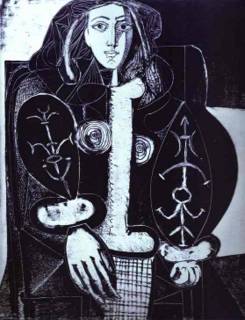
"the girls would turn the color of an avocado"
Coleman Hawkins, Picasso.
"Picasso" is one of the first unaccompanied saxophone pieces ever recorded, perfection in solitude, and a challenge for succeeding generations of sax players to take up, from Sonny Rollins, who recorded a number of solo performances in the '50s, to Anthony Braxton's For Alto and Julius Hemphill's Blue Boye, massive solo double-LPs that took the concept about as far as humanly possible.
Coleman Hawkins turned the tenor saxophone from a jokey horn fit for marching bands and circuses into the defining instrument of postwar jazz, a role it has never relinquished*. He did it with precision and with genius; he created the basic grammar of the tenor sax, establishing how the sax ought to sound. He started playing professionally before "The Charleston" was released, and died just before Abbey Road was.
"Picasso" was recorded for a Norman Granz jazz compilation and can be found on this good general Hawkins collection.
What was Picasso himself doing in 1948? An uneventful year--medals from Poland, medals from France, exhibitions, Francoise Gilot. The above lithograph is Woman in an Armchair.
* (by contrast, consider the yo-yoing prominence of the saxophone in modern pop music--from rivaling the electric guitar as the essential ingredient of '50s rock and roll, to its banishment in the Beatles-soaked years (while hanging on in soul and funk), to its slight return as a cheap signifier of "mood" or "class" in the '70s (think "Baker Street", or "Year of the Cat", or Phil Woods on those interminable Billy Joel songs), to its brief, gaudy resurgence in the '80s, with the likes of Springsteen and Glen Frey hauling the sax solo back into the top 40 and Rob Lowe playing a sax-wielding stud in St. Elmo's Fire. And then suddenly, around the time the Berlin Wall fell, the saxophone essentially vanishes from pop and rock, never to return?, existing only as a ghost in samples.)
No comments:
Post a Comment